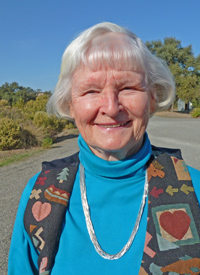Joann Leach Larkey

Local historian JoAnn Larkey has been researching and writing about the history of Yolo County for nearly 50 years. Her extensive knowledge of past events paints a rich story for the local community and provides valuable information for the area that has become the Cache Creek Nature Preserve.
Can you tell me your name, occupation, and describe where we are?
My name is JoAnn Leach Larkey and you would consider me a local historian or a Yolo County historian. We’re at the Cache Creek Nature Preserve, which was set aside and preserved for posterity. We’re sitting in a wonderful little barn. It’s very well constructed with lots of wonderful farm machinery sitting around. It reminds me of my childhood days when all of this equipment was still being used.
How long have you been researching and writing about Yolo County?
Well, I’ve been researching and writing Yolo county history since about 1963. I got interested in a project that was starting in Davis, and one thing led to another.
Who were the first people on this land, and how did they use it for agriculture?
The first people--and we know very little of the Native Americans who were living here--had been here since probably the 1600s or even earlier. We don’t know exactly when they came, because they don’t have a written language. They did a lot of fishing in the rivers and streams, and I think we’re only now coming to appreciate how well developed their system of working with nature was to provide for large populations of people that lived in this area.
Can you give an overview of who came afterward?
The first people that we know of would have been the native population. Then there would have been the hunters and trappers, both British and American. They used the land and rivers for acquiring hides and furs. The British were part of the Hudson Bay Company, and they came down from the Columbia River. The others started coming in the 1830s and 40s. A southern group came with the Workman-Rowland Party, and they were the ones that came with pack horses and large families. The Gordon family came almost directly to Cache Creek. Another group came from Missouri. They were the first to come with wagons. They didn’t all make it with their wagons the first time around (chuckles). I think it was 1844 before they actually got wagons all the way across. Many of them stayed right here in the Sacramento Valley.
When did this area become part of Spain, and was it used at all for agriculture?
In 1821, there was a revolt in Mexico that led to the end of Spanish rule in the new world. The only Spanish incursion into the Sacramento Valley occurred in 1821 when the Spanish government sent an expedition through this area. They camped one night on Putah Creek. Fortunately, the priest who came along with the expedition kept diaries. Those are really the first first-hand accounts of the native people. The other accounts would be the records in the Spanish missions, because whenever they needed somebody to help harvest the crops, they would round up the Indians and take them, or relocate them, to mission settlements.
What happened here during the Bear Flag revolt?
Colonel Fremont was heading a government expedition, and I think it just congealed. The people decided it was time that California ought to become American. They started a revolt and took a group through the mountains and converged on the Mexican settlement at Sonoma. General Vallejo was in charge of that, and he ruled with an iron hand. But the revolt only lasted one day; they captured General Vallejo and several others and brought them to Sutter’s fort. [Vallejo and the others] were incarcerated for maybe five or six days, and then people forgot about the whole thing. But that started the Mexican war. One of [William] Gordon’s descendants told me one time, when Fremont came to their ranch, he demanded horses for his troops. He said that he wasn’t going to give them any. So Fremont said, “If I don’t get them by tomorrow morning, you’ll be shot.” [Then], during the night, the Indians who were working with William Gordon, took the horses away. There weren’t any horses to be had the next morning. I thought that was a fascinating story (chuckles).
What fascinates you most about the history of the area that is now this preserve?
It’s just incredible that people, including the native people, could come to a place and use what was here to their advantage. Weave the kinds of baskets that they made, which were watertight. You only needed to heat a rock to boil water inside your basket to have dinner. I mean, that was very simple but pretty ingenious, that the women were able to make baskets that fine! It’s amazing to me that they saw these resources.
Why do you think it’s important for residents to have a sense of their local history?
Well I’ve always felt that it’s important for people to know a little bit about the place where they live. I think it gives them a sense of belonging to a community, and it also gives them an appreciation of what’s gone before.
To download the audio, right click on the audio link above and scroll to "Save link as . . ." and choose the directory where you want to store the mp3. In Windows, you may have to use Control + S to select the link.